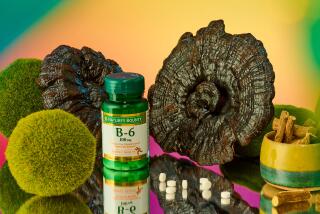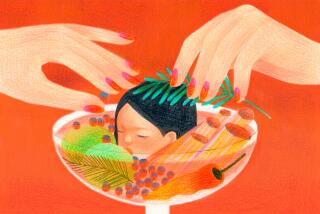Hair of the doc?
- Share via
RUM allegedly cured the king of Spain’s deadly flu. A concoction of aromatic bitters kept Simon Bolivar’s South American troops healthy, and daily doses of brandy are credited with helping several Catholic popes live long, healthy lives.
Of course, all this was a long, long time ago, when liqueurs, aperitifs and other alcoholic beverages weren’t found behind the bar as often as they were by the sickbed.
Ancient Greeks, Romans and Egyptians drank wine and ale for recreation and, on occasion, remedy. But it wasn’t until the Middle Ages that alcohol’s purported healing power became its biggest selling point.
In the 1300s, medieval doctor-chemist Arnaud de Villeneuve distilled wine into a more potent alcohol he called eau de vie, or “water of life.” Eau de vie, Villeneuve claimed, was a master of all medicines. Several drops in the morning could cure not just the common cold, he averred, but senility and sadness too.
The drink -- now known as brandy -- achieved wild popularity throughout Europe. Some even staunchly defended its ability to clear up red, itchy eyes, cure liver disease and prevent loss of memory.
Brandy wasn’t alone on medieval healers’ shelves. Other herbalists discovered that if they steeped herbs in alcohol, instead of water, the result was an infusion more potent than herbal tea. Medicinal claims attached themselves to more than a few of the resulting liqueurs. Benedictine, invented in the early 1500s, was concocted as a cure for malaria, as were (by some accounts) Campari and vermouth.
Beers also were brewed using medicinal herbs. Norwegian brewers used juniper to make an ale for treating urinary tract problems. The English used an herb called borage in an ale for depression, and for coughs they used horehound, which is still found in some cough drops.
Even made from hops, as it was from the 1500s on, beer was still of medicinal value. The soporific herb could allay anxiety and insomnia; containing plant estrogens, it was often prescribed to women in menopause.
The symptoms of menopause also caught the attention of an Italian herbalist’s daughter-in-law. In 1845, Bernardino Branca combined 40 herbs and spices to come up with the bitter liqueur now known as Fernet-Branca. His daughter-in-law, Maria, came up with the marketing claims for the drink: It cured fever, killed parasites, stimulated appetites and quelled headaches, in addition to easing menstrual cramps (claims that kept it on the market legally through Prohibition in the U.S.).
Medicinal properties weren’t reserved solely for liqueurs and aperitifs. European colonists in the tropics in the 18th and 19th centuries favored gin and tonic for keeping scurvy and malaria at bay.
There was something to this: The drink was made with lime, which brought with it a dose of vitamin C, and the tonic contained quinine, which native Americans had long before recognized as a cure for malaria. Three years ago, German researchers put the drink to the test. They found it could bring blood levels of quinine high enough to potentially protect against malaria for a few hours -- but not much longer than that.
Mint juleps, rum and brandy all were once thought to help prevent and cure malaria -- as well as yellow fever, dysentery and rheumatism. In the 19th century, a British army captain serving in India noticed his troops seemed healthier than the locals, an effect he attributed to rum.
And he may not have been all wrong: Avoiding contaminated water in favor of alcohol probably saved more than a few of his soldiers from gastrointestinal distress.
A fair amount of drink, including rum, was included in the British soldiers’ food rations at the time. But before long, some army medical officers began to conclude that drunken soldiers posed more risks than benefits. One medical officer even noticed a link between heavy drinking and liver disease -- a link that doctors today firmly accept.
But soldiers went on drinking -- and patients throughout Europe and America did too. Alcoholic drinks were used to hasten bloodletting and dull pain during surgery. Wine was prescribed to quicken the pulse, calm hysteria, cure cholera and reverse a sickly looking pallor.
Because for all their drawbacks, alcoholic remedies had one thing going for them: Patients rarely missed a dose.
More to Read
Sign up for The Wild
We’ll help you find the best places to hike, bike and run, as well as the perfect silent spots for meditation and yoga.
You may occasionally receive promotional content from the Los Angeles Times.






